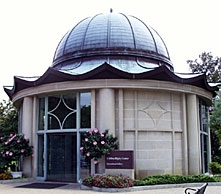Scott Nolley (Fine Art Conservation of Virginia) began his talk by addressing the idea of advocacy in its broadest forms. Though the word advocacy is frequently used in modern contexts as a buzzword for progress (much like diversity or sustainability in other arenas) Nolley defined it specifically as “speaking and acting on behalf of oneself and others.”

Nolley went on to explain that advocacy in conservation is a natural conclusion. For example, advocacy requires an inherent cooperation of allied professionals as well as colleagues. Conservators have relied on a collaborative relationship with material scientists and industrial engineers since the inception of the field. This collaborative spirit continues to expand our conservation toolbox as new analytical methods and treatment options are discovered and perfected. Furthermore, Nolley described that though the personalities of conservators can sometimes fall on the introspective side, the near-visceral interest in cultural property that attracts one to the job makes the conservator the perfect advocate for our shared heritage.
Nolley traced this tendency toward advocacy through a history of the “professional family” of personalities that colored the foundational years of conservation education. He cited notables such as Rutherford Gettens and George Stout, as well as Donald and Caroline Keck, and indicated that the tradition of mentorship and the near-apostolic succession of protégés that developed within the US conservation training programs contributed to the character of the profession for many years. However, the proliferation of specialties and the growing dialog with allied professions have contributed to make the field of conservation less insular, if not less colorful.
This fact combined with a world driven by economic imperatives and moving at an ever increasing speed means that a new level of advocacy must be taken on by conservators in their respective practices. Nolley stated that advocacy for the profession becomes an “essential food group” as funding becomes less available and more focused. Furthermore, advocacy is a logical component of development and education, and perhaps should be specifically added to the pedagogy for rising conservators.
Finally in his talk, Nolley discussed some ways in which we see advocacy working in conservation today. He noted that in his private practice, he has engaged in avenues of advocacy in academic environments, working on-site in public view, as well as with his private clients. Using the example of a treatment of a portrait by the painter Thomas Sully (1783 –1872), Nolley explained how in the process of reconnecting the artifact to the historic record, he simultaneously became an advocate for the painting itself, the painter by proxy, the sitter, and the present owner. Advocacy, he concluded, can lead to new projects, research opportunities, publication, and engenders a continuous dialog. And it can be as easy as just showing up.
Summarized by Desirae Peters, 4th year Graduate Intern at the Smithsonian American Art Museum and Quinn Ferris, 4th year Graduate Intern at the University of Virginia Library and Special Collection